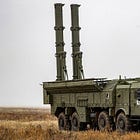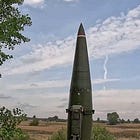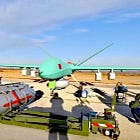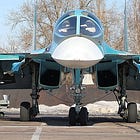The Ukrainian military news website Militarnyi recently disclosed unit costs for various Russian strike munitions derived from leaked Russian procurement documents. This reporting not only offers a window into Russia’s wartime production of strike munitions, but is relevant to military dynamics elsewhere in the world at a time when countries are reassessing their strike munition requirements.
Cruise Missiles
According to Militarnyi, the leaked Russian procurement documents indicate that the 9M728 land-attack cruise missile, which the Ukrainian military refers to as the Iskander-K, remains in production. A total of 303 9M728 cruise missiles were reportedly contracted for delivery in the 2024-2025 timeframe at an average cost of around US$1.5 million per missile. The 9M728 is a vestige of the now-defunct Intermediate Range Nuclear Forces Treaty (INF Treaty). To comply with the range and payload restrictions of the INF Treaty, the 9M728 has a reported maximum range of 500 kilometers while equipped with a 480-kilogram warhead. The ongoing production of the 9M728 in the post-INF Treaty era is likely explained by the existence of an active production line that Russia was unwilling to shut down in wartime in light of the major shortfall of strike munitions from February 2022 onward. While this amounts to a plausible, even logical, explanation for the continued production of the 9M728, this land-attack cruise missile is far too limited in range to be practically employed even in the specific military-geographical context of the Russia-Ukraine War, let alone against targets spread out across NATO member states. It is not clear why Russia has not substituted payload for range so as to develop a lower-payload but extended-range version of the 9M728 that can be used to attack targets in Ukraine located further from the frontlines/international border.
The 9M728 appears to remain in production alongside the much longer-range 9M729, a closely related land-attack cruise missile that was the proximate cause for the demise of the INF Treaty. Whereas the 9M728 is reported to have a maximum range of less than 500 kilometers, the 9M729 is said to have a maximum range of more than 2000 kilometers. According to Militaryni, Russia was contracted to receive 95 9M729 cruise missiles in 2025 with an average cost in the region of US$1.4-1.8 million per missile. Supposing that the reported cost figures for the 9M728 and 9M729 are both accurate, Russia evidently has little reason to maintain the shorter-range 9M728 in production once the war comes to an end and Russian industry has time to reallocate production capacity toward higher-priority armaments. It bears emphasis that there is little information in the public sphere to indicate the large-scale use of the 9M729 in the Russia-Ukraine War. It is possible, even likely, that these long-range land-attack cruise missiles, which can be used to attack targets well beyond even the most distant sections of Ukrainian territory, are being stockpiled with a war with NATO in mind.
The 9M728 and 9M729 are related to the sea-launched 3M14, which is better known as the Kalibr. The so-called “Kalibrization” of the Russian navy over the 2010s led to the absurd manner in which Russia has employed 3M14 land-attack cruise missiles over the course of the Russia-Ukraine War. The relevant surface ships and submarines of the Russian Black Sea Fleet leave port, launch a handful of available 3M14 land-attack cruise missiles, and immediately return to port to rearm (assuming that reloads are available). All things considered, Russia would be better served if 3M14 Kalibr land-attack cruise missiles could be launched from a ground-based launcher to attack targets in Ukraine—the irregular sorties of the remaining warships of the Black Sea Fleet with the aim of launching such long-range cruise missiles against fairly proximate targets in Ukraine amount to a needless waste of fuel.
Whatever the shortcomings of the 3M-14 in the specific military-geographical context of the Russia-Ukraine War, this naval land-attack cruise missile design remains useful to the Russian military in other contexts and for other roles. According to Militarnyi, Russia contracted the manufacturer to deliver a total of 240 3M-14 cruise missiles in the 2022-2024 timeframe, and an additional 450 3M-14 cruise missiles in the 2025-2026 timeframe. According to Militaryni, the average cost of each 3M-14 was US$2 million. Militarnyi reports that Russia ordered an additional 56 nuclear-armed 3M-14S cruise missiles for delivery between 2024 and 2026.
The bulk of the land-attack cruise missiles that Russia has employed in the Russia-Ukraine War are air-launched designs, particularly the in-production Kh-101, which is launched by Tu-95 and Tu-160 bomber aircraft—Russia’s Tu-22M bombers can only launch Kh-22/Kh-32 supersonic cruise missiles. According to Militaryni, Russia ordered 525 Kh-101 air-launched land-attack cruise missiles for delivery in 2024 at an average cost of around US$2 million per missile. According to Militarnyi, Russia ordered an additional 700 Kh-101 missiles for delivery in 2025 at an average cost of US$2 million-2.4 million per missile.
It is worth noting that the 9M728 and 9M729 are operated by the Russian army, the Kh-101 by the Russian air force, and the 3M-14 by the Russian navy. The Russian army also operates the Geran-3, which is a turbojet-powered version of the ordinarily propeller-driven Shahed-136/Geran-2 strike drone. The Russian army—not the Russian air force—also operates the air-launched Banderol land-attack cruise missile. Russia recently unveiled a ground-launched version of the Banderol, which will presumably also be operated by the Russian army, at a military-industrial event in Perm.
Ballistic Missiles
The primary non-nuclear ballistic missile employed by the Russian military is the 9M723 Iskander, which is operated by the Russian army. An INF Treaty-compliant design, the Russian army deployed the Iskander to replace the OTR-21 Tochka, a much shorter-range Soviet ballistic missile design that fulfilled a very different battlefield role. Although the Russian army units operating the Iskander were primarily intended to operate in support of corps- and division-sized ground combat formations, wartime necessity and the absence of meaningful availability of substitutes have resulted in the regular employment of Iskander ballistic missiles as both a deep strike munition in pre-planned attacks and a means of undertaking short-notice “dynamic” attacks against fleeting battlefield targets. According to Militaryni, Russia ordered 1202 Iskander ballistic missiles for delivery in the 2024-2025 timeframe. These ballistic missiles were reportedly ordered in several distinct warhead configurations at a unit cost of between US$2 million-3 million per missile.
With a maximum range of 500 kilometers while equipped with a 500-kilogram warhead, the 9M723 Iskander lacks the range required to attack targets in much of Ukraine. Russia has reportedly been working on an extended-range version or derivative of the 9M723 Iskander. The Militaryni report speculates that a contract for 18 9M723-2 ballistic missiles may refer to an extended-range Iskander version/derivative. If and when Russia deploys a 1000-kilometer-range conventionally-armed ballistic missile, it will be able to attack targets located in most of Ukraine with what remains a high probability of penetration strike munition, notwithstanding the gradually increasing deployment of Patriot and SAMP/T ballistic missile defence-capable air defence systems across Ukraine. Such a ballistic missile will also allow Russia to undertake more complex multi-axis ballistic missile attacks against a wide range of targets in Ukraine, which is one approach to defeating air defence systems that rely on radars that have a fixed 120° field of view.
While the Russian army operates the 9M723 Iskander, the Russian air force operates an air-launched ballistic missile, the 9-S-7760 Kinzhal, which the Ukrainian military regularly refers to as the Kh-47. A single 9-S-7760 Kinzhal can be carried by launched by each specially configured MiG-31K aircraft, a small number of which are operated by the Russian air force’s Long Range Aviation, which otherwise operates Tu-22M, Tu-95, and Tu-160 bomber aircraft. The performance of the Kinzhal has been underwhelming throughout the Russia-Ukraine War. While this dynamic has been shaped by both baseless Russian hype and widespread misunderstanding as to what a “hypersonic” air-launched ballistic missile is and is not, it ultimately reflects the limitations of this Russian strike munition. According to Militaryni, Russia contracted for the delivery of 44 Kinzhal missiles in 2024 and an additional 144 air-launched ballistic missiles in 2025 at an average unit cost of US$4.5 million.
While the Kinzhal offers flexibility and greater range than the Iskander, the difference in cost and the very small salvo sizes that Russia can sustain with the small fleet of specially configured MiG-31K aircraft, as well as its underwhelming performance against Ukraine, raises questions about the long-term role of the 9-S-7760 in the Russian military. Israeli and Chinese air-launched ballistic missiles constitute examples of designs that Russia may emulate going forward.
The Militaryni article does not mention the 300 mm diameter guided artillery rockets used with the Russian army’s BM-30 Smerch and Tornado-S systems, which are more natural replacements for the OTR-21 Tochka short-range ballistic missiles than the 9M723 Iskander in battlefield support roles in a context in which the Russian air force is poorly positioned to undertake close air support strikes, let alone interdiction strikes behind the frontlines. The scale at which Russia has been producing guided 300 mm artillery rockets—short-range and low apogee/maximum altitude ballistic missiles by another name—is not public knowledge. It bears emphasis that there is little indication of the widespread and regular use of such missiles over the course of the Russia-Ukraine War.
One of the most consequential non-events in the Russia-Ukraine War has been the apparent non-availability of large numbers of guided 300 mm artillery rockets, with large numbers here referring to the availability of such an arsenal as to sustain the expenditure of at least several hundred such missiles per month. It is worth noting that the United States is currently producing over 14,000 of the admittedly much smaller, lighter, and shorter-range 227 mm GMLRS guided artillery rockets/missiles per year and plans to increase output to 28,000 GMLRS guided artillery rockets/missiles per year in 2028. The Russia-Ukraine War would likely have taken on a very different course had Russia been able to attain an annualized 300 mm diameter guided artillery rocket production output even an order of magnitude smaller than the United States’ current output of GMLRS missiles (i.e., some 1400 300 mm diameter guided artillery rockets per year).
Another Russian ballistic missile not mentioned in the Militarnyi report is the Oreshnik, which is understood to be an intermediate-range ballistic missile (IRBM) design. As of this writing, it is unclear which Russian military service will operate the Oreshnik. The Russian army may be a natural candidate given its experience with the 9M723 Iskander, but Russia’s Strategic Rocket Forces, which operate its nuclear-armed ground-based intercontinental-range ballistic missiles of both the silo-based and mobile wheeled launcher variety, has much more experience with operating such a large and long-range ballistic missile design. Should the Oreshnik be developed and deployed in a conventionally armed configuration while operated by Russia’s Strategic Rocket Forces, this long-exclusively nuclear-armed part of the Russian and Soviet militaries may evolve along the lines of China’s People’s Liberation Army Rocket Force. Such a development will likely affect how Russia will approach conventionally armed ballistic missiles with a maximum range of 1000 or more kilometers.
If there are any “universal” lessons of the Russia-Ukraine War that can be readily extrapolated to other countries and contexts, these concern how strike munitions must be available in very large numbers at the outset of a major war and production capacity must exist to quickly replenish stocks over the course of a war. Russia went to war in February 2022 without a suitably sized arsenal of strike munitions and a very limited capacity to quickly replenish its rapidly depleted stocks, let alone greatly expand upon such stocks. As a result, Russia’s strike campaigns have been essentially undertaken hand-to-mouth over the course of the Russia-Ukraine War, with little scope for Russia to build up a meaningful stockpile without severely throttling launch activity. Only the availability of Shahed-136/Geran-2/Garpiya single-use propeller-driven strike drones has allowed to undertake regular large-scale strike munitions launches against targets located more than 50 or so kilometers from the frontlines, and it bears emphasis that the non-availability of other strike munitions in the required numbers has led Russia to regularly employ its Shahed-136/Geran-2/Garpiya strike drones in a decidedly suboptimal manner as an ersatz cruise missile. The recent reporting from Militarnyi may suggest that Russia is rapidly expanding its strike munition arsenal, but wartime realities mean that restrictive supply continues to throttle demand.








